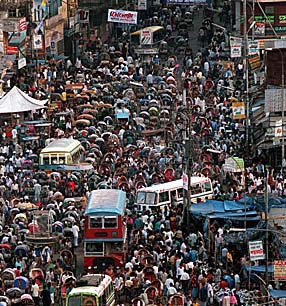India's population put at 1.21 Billion, growth rate declines

The population of the country as per the provisional figures of Census 2011 had been put at 1.21 Billion of which of which 637.2 million (51.54 per cent) are males and 586.46 million (48.46 per cent) are females.
The provisional figures of Census 2011 were released in New Delhi on Thursday by Union Home Secretary GK Pillai and RGI C Chandramouli.
According to the provisional figures, the population of the country increased by more than 181 million during the period 2001-2011, a rise of 17.64 percent. The rise in male population was put at 17.19 per cent while the population of females increased by 18.12 per cent.
Incidentally, 2001-2011 is the first decade (with the exception of 1911-1921) which has actually added lesser population compared to the previous decade.
Uttar Pradesh with 199.5 million inhabitants continues to be the country’s most populous State in the country followed by Maharashtra with 112 million.
However, the percentage decadal growth rates of the six most populous States have declined during 2001-2011 compared to 1991-2001. Of this, the rate of growth in Uttar Pradesh has fallen from 25.85 per cent to 20.09 per cent, Maharashtra saw a decline from 22.73 per cent to 15.99 per cent, Bihar 28.62 from per cent to 25.07 per cent, West Bengal from 17.77 per cent to 13.93 per cent, Andhra Pradesh from 14.59 per cent to 11.10 per cent and Madhya Pradesh (24.26 per cent to 20.30 per cent.
During 2001-2011, as many as 25 States and Union Territories with a share of about 85 per cent of the country’s population registered an annual growth rate of less than 2 per cent as compared to, 15 States and Union Territories with a share of about 42 per cent during the period 1991-2001.
As many as 15 States and Union Territories have grown by less than 1.5 per cent per annum during 2001-2011, while the number of such States or Union Territories was only 4 during the previous decade.
The total number of children in the age-group 0-6 is 158.8 million (-5 million since 2001)
Twenty States and Union Territories now have over one million children in the age group 0-6 years. On the other extreme, there are five States and Union Territories in the country that are yet to reach the one hundred thousand mark.
Uttar Pradesh (29.7 million), Bihar (18.6 million), Maharashtra (12.8 million), Madhya Pradesh (10.5 million) and Rajasthan (10.5 million) constitute 52 per cent children in the age group of 0-6 years.
Population (0-6 years) 2001-2011 registered negative -3.08 percent growth with minus -2.42 for males and –3.80 for females.
The proportion of Child Population in the age group of 0-6 years to total population is 13.1 percent while the corresponding figure in 2001 was 15.9 percent. The decline has been to the extent of 2.8 points.
Overall sex ratio at the national level has increased by 7 points to reach 940 at Census 2011 as against 933 in Census 2001. This is the highest sex ratio recorded since Census 1971 and a shade lower than 1961. Increase in sex ratio is observed in 29 States/UTs.
Three major States (Jammu and Kashmir, Bihar and Gujarat) have shown decline in sex ratio as compared to Census 2001.
Kerala with 1084 has the highest sex ratio followed by Puducherry with 1038, Daman and Diu has the lowest sex ratio of 618.
Child sex ratio (0-6 years) is 914. Increasing trend in the child sex ratio (0-6) seen in Punjab, Haryana, Himachal Pradesh, Gujarat, Tamil Nadu, Mizoram and Andaman and Nicobar Islands. In all remaining 27 States and Union Territories, the child sex ratio show decline over Census 2001.
Mizoram has the highest child sex ratio (0-6 years) of 971 followed by Meghalaya with 970. Haryana is at the bottom with ratio of 830 followed by Punjab with 846.
Literacy rate has gone up from 64.83 per cent in 2001 to 74.04 per cent in 2011 showing an increase of 9.21 percentage points.
Percentage growth in literacy during 2001-2011 is 38.82; males : 31.98 per cent and females : 49.10 per cent.
Literates constitute 74 per cent of the total population aged seven and above and illiterates form 26 per cent.




 Is this Shakti movie story?
Is this Shakti movie story? Hearing adjourned in Sirija's dowry harassment case
Hearing adjourned in Sirija's dowry harassment case